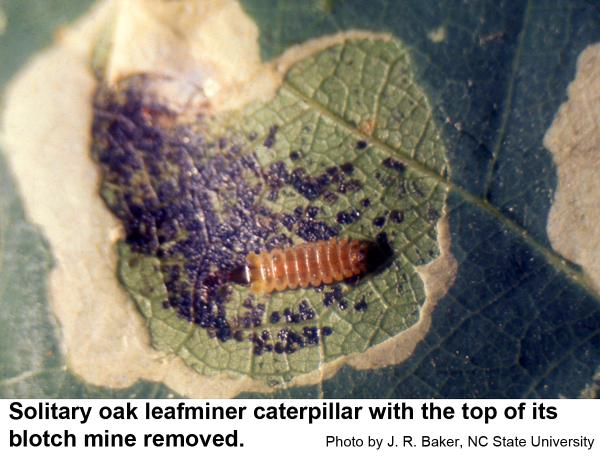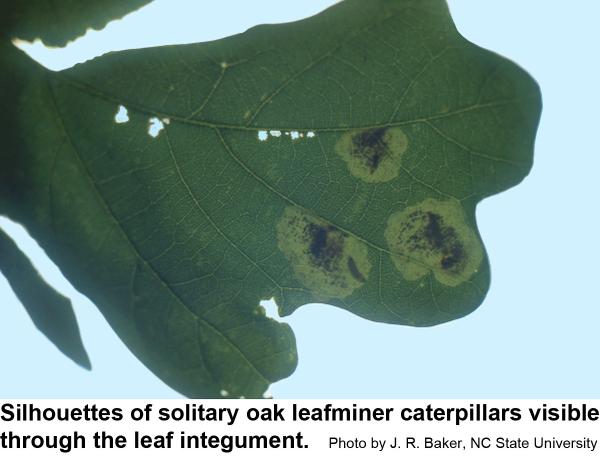Description and Biology
Solitary oak leafminers, Cameraria hamadryadella, are tiny caterpillars that feed between the outer layers of oak leaves. They are small, flat, taper toward the rear and are shaped somewhat like the rattles of a rattle snake. Mature larvae are about 1/4 inch long. As solitary oak leafminers feed they form irregular, blotch-like mines. As their name implies, only one leafminer occurs in each mine. Mature leafminers spin a flimsy, white, oval cocoon within the leaf and pupate within it. Solitary oak leafminer pupae are slender, brown, and taper toward each end. Pupae wriggle to the surface of the mine and new adults emerge that are pale, silvery moths with bronze blotches on the wings. These moths are so small they are termed "microlepidoptera." This insect overwinters as diapausing larvae in fallen leaves. A new generation of tiny moths emerges during the spring. After mating, females cement eggs one at a time to the upper surface of leaves. We have two or more generations per year in North Carolina.
Host Plants
Solitary oak leafminers sometimes infest burr oak, eastern black oak, and red oak, but prefer white oaks. This insect is usually more common on oaks growing in natural areas. Heavy infestations cause browning and premature leaf drop. This injury is largely cosmetic. If severe, infested leaves may die, but the overall health of the tree is rarely in danger.
Residential Recommendations
Because the insect overwinters in fallen leaves, leaf disposal or destruction is effective in reducing their population (this would have to be carried out around all oaks in the immediate area). Parasites and predators seem to kill from 21 to 25% of these leafminers whether the leafminers are abundant or sparse. At certain times oaks may be more resistant to solitary oak leafminers than at others. Even though solitary oak leafminer mines may be alarming, real consequences to health of the tree is minimal. Chemical treatment is not recommended.
Other Resources
- Density-related mortality in Cameraria hamadryadella (Lepidoptera: Gracillariidae) at epidemic and endemic densities. Connor E. F. and M. W. Beck. 1993. Oikos 66: 515-525.
- Solitary oak leafminer, Cameraria hamadryadella, and gregarious oak leafminer, Cameraria Cincinnatiella. Anonymous. No Date. Oak Pests - A Guide to Major Insects, Diseases, Air Pollution and Chemical Injury.
- Species Cameraria hamadryadella - Solitary Oak Leafminer - Hodges#0823. Balaban, J. et al. 2013 (last update). Bugguide. Iowa State University Department of Entomology.
- Extension Plant Pathology Publications and Factsheets
- Horticultural Science Publications
- North Carolina Agricultural Chemicals Manual
For assistance with a specific problem, contact your local N.C. Cooperative Extension Center.
This Factsheet has not been peer reviewed.
Publication date: Feb. 13, 2019
Reviewed/Revised: June 25, 2022
N.C. Cooperative Extension prohibits discrimination and harassment regardless of age, color, disability, family and marital status, gender identity, national origin, political beliefs, race, religion, sex (including pregnancy), sexual orientation and veteran status.





